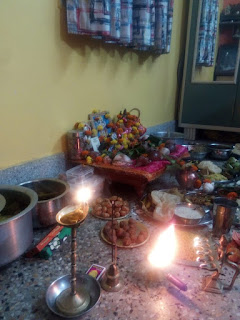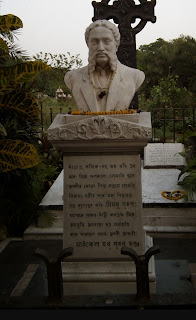The Kojagori Laxmi Puja - an introspection on rituals and customs
If the wind gets cooler, and the paddy harvest reaches the rural homes, the people who live in the vast hinterland of mangroved riverine delta of aluvial soil begin to celebrate the annual festivity of prosperty and wealth ( Kojagori Lokhi variously known as Laxmi, Mahalaxmi) on the night of full moon, the Purnima as per Hindu calendar
Evolving Vedic belief and Puranaic text revers Laxmi as the vedic Goddess and worshiped as the spouse of Vishnu. However, the discourse on Sri Laxmi over various scriptures, Ramayana and Mahabharata point out that Laxmi has two other lineages - one with Indra, the first amongst the Gods mentioned in the Vedas;Kuber cannot be ignored while worshipping Laxmi.
The Purana says that Laxmi came out of the great churning of the sea by the Gods and the Assuras. In period of vedic conquer of forest and hill tribes, Laxmi remained a lucky daughter of the local tribes, the Asurras.it is interesting part of social engineering that took place during the era of northern Indian culture (the population living above the Vindyachal mountain range) ensured defeat of the Assuras and subjugation of the defeated tribes into the new religious mould , where Assuras, Rakshas and the other hill and forest tribes were placed at the lowest rung of the social hierarchy.
Laxmi has been worshipped in the eastern region of South Asia as the central Goddess who bestows wealth, peace and happiness. Since pre-vedic time, the pagan folklore and gala feast ritual in each home continuese till date. No wonder that the old rituals of fish as part of the God's food menu continues unhindered.Especially fish with scales like Hilsha or Rohu are consumed as Prasad.
One would be thrilled to notice that the puja-Ghot, the tiny container, usually of the copper or the bronze make, in which water is stored and all the holy rivers are invoked, is also the focal symbolic object for invoking the spirit of the Gods and Goddesses.
If it's Kojagori Laxmi, a tradition still exists in some families to craft a small play- boat out if banana-steam and offer it to the Goddess. A few families are also adept in the making of a boatman sitting on the boat. Next day , at the end of Purnima ( the end of full moon phase), those worshipped boats are carried to the river and set to float away. This ritual indicates that the traders using boat in prehistoric time and a section of the folks involved in fishing based livelihood , were worshipping their tools of trade. In the pre-historic times, in the eastern belt of South Asia,the worship of the earlier totems like a few specified plants, stones , specific sea shells like kori, have percolated down many thousand generations and the ritual continued till date.
In this context , it is not ignorable to note that Aam pancha-pallav ( five-leaved fresh shoot of Mango tree ) is not commonly placed upon the Ghot in any other parts of South Asia while worshipping any idol of God.
While discovering the aborigine source of Kojagori Laxmi , it is apoarent that Kojagori Lokhi is distinctly different in the tone of rituals of Mahalaxmi puja that is worshipped during dewali time . While Kojagori diacourages sound and worshipped in Purnima( full moon night ) , and owl as it's pet bird ,the other deity is worshipped with full of sound of bell and fire crackers and in the night of Amabashya (moon-less night) and the pet animal that accompany her idol is elephant.
While exploring South Asia's eastern aborigine inhabitants, the forest and hill dewellers, we would do a great disservice to this article , if we miss out an equally important ritual of ancient origin centering around consumption of Pan -Supari.! Betel leave and areca nut have always been offered to Ma Laxmi, even Ma Saraswati is not entitled to this post-meal mouth freshener - the red colouring agent for lips, and still a popular addictive agent . Pan- Supari often gets a passing reference in the offering to God. But it's real significance emerges when one keenly watch the longest festival of the east - the Durga Puja. Devi Durga and her four family members cannot start the journey for immersion in the nearest river or water body until the traditional yet mandatory ritual of Boron with pan and supuri by womenfolk comes to an end.
#river #riverinefishes #kojagorilokhi #boat #water #assuras #sea #mythology #ved #puran #tribes #aborogines #bengaliculture #laxmipuja #laxmi #Hilsa #betelleaf #betelnut #ghotpujo #pujoghot #mango #coconut #babana #fishingfolk #durgapuja








Good interpretation but need more. Undoubtedly Durga, laxmi,or any other idol is nonaryan origin.
ReplyDeleteGood interpretation but need more. Undoubtedly Durga, laxmi,or any other idol is nonaryan origin.
ReplyDelete